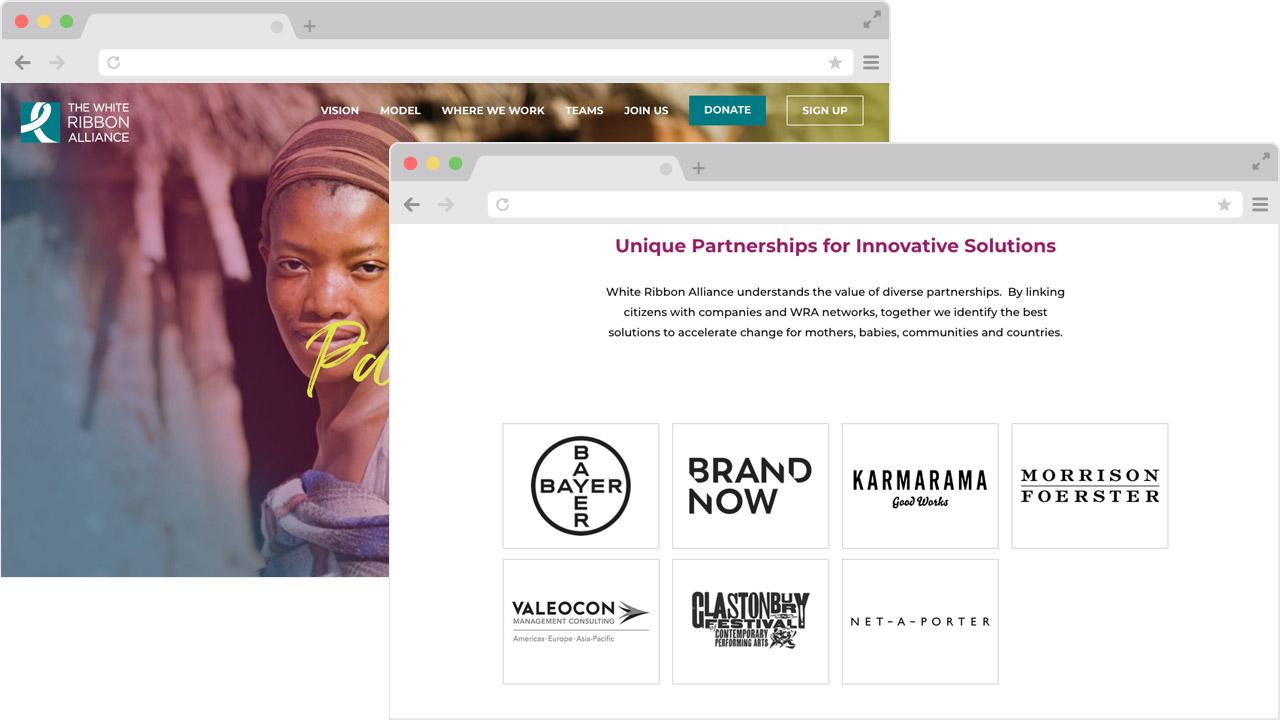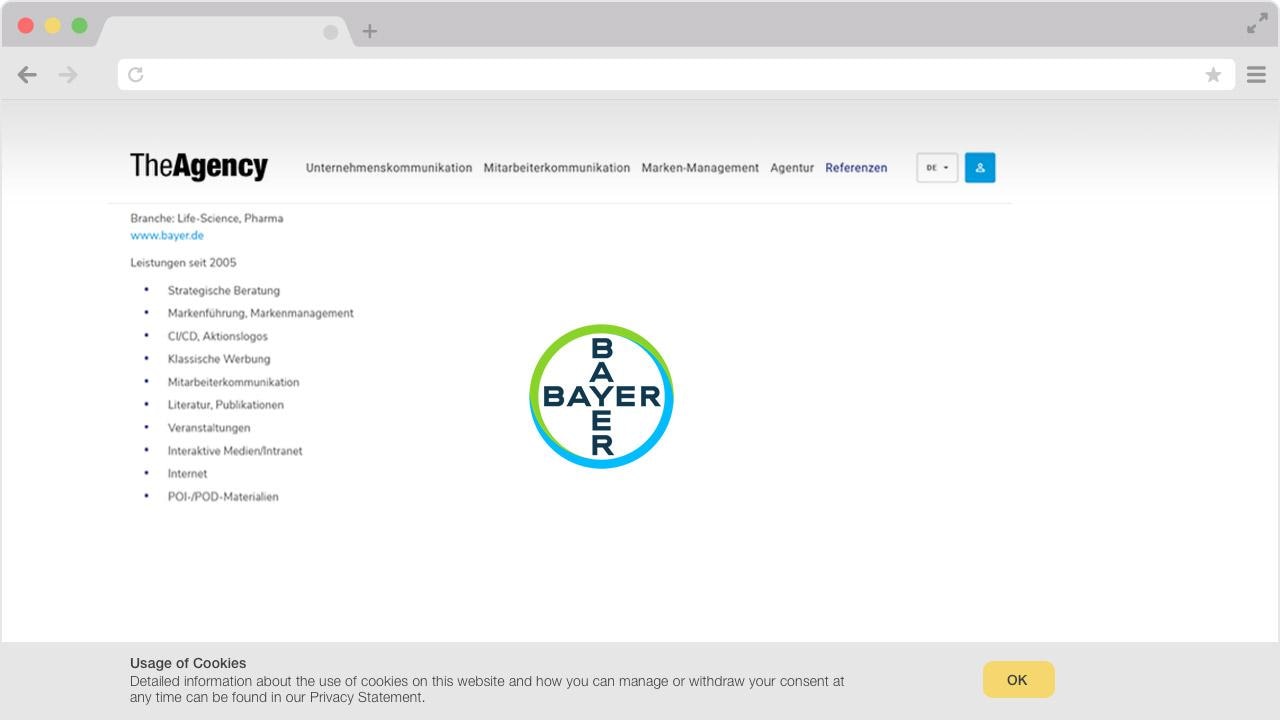Forms of Co-Branding
Co-branding involves the collaborative use of brands from two or more companies. We use the term co-branding for:
If you have any further questions about this or any other section of Bayer Identity Net, please contact:
Reference advertising
Our business partners are very interested in using the name Bayer and the Bayer logo to publicize the fact they are working with us. This is only possible if explicit written consent has been obtained from Corporate Trademarks or Brand Management.
Basically speaking, third parties are not permitted to use the Bayer and Bayer logo trademarks, and exceptions are only made after a thorough review. This is because the name Bayer and the Bayer logo as well as our product logos are important assets and valuable, protected trademarks and must be handled with great care and respect.
Only preferred partners and main suppliers who co-operate closely with Bayer or where Bayer is a key client and it is Bayer’s intention to cultivate a substantive, long-term collaboration will be allowed to display the name Bayer and/or the Bayer logo e.g. on their website. Just because some person or some company once worked for or with Bayer does not entitle them to use the Bayer trademarks. Only the Bayer Cross logo or the corporate logo featuring the Bayer Cross with Bayer may be used.
Examples of co-branding
Any request by a third party must be thoroughly reviewed from a legal and corporate branding perspective. If the outcome of the review is positive, Corporate Trademarks will issue a Consent Declaration regulating all the details.
Please contact Brand Management or Corporate Trademarks and have the following information ready:
The complete name and address of the partner.
Is it a well-known partner with a long-standing business relationship?
What is the benefit for Bayer? The benefit for our partner is very often more evident and Bayer only benefits from the partner’s use of our logo if this is an important business relationship. By accepting the partner’s request, we will be doing the partner a favour, which will strengthen that mutual relationship.
Where does the partner want to use our logo and in which context? On the website, in brochures, presentations, at sponsored events, at trade fairs, or in advertising? It would be good to see not only where but also how our logo will be used.
A Consent Declaration will be issued for a period of three years and can be easily terminated at any time.
References – how our company trademarks are used by third parties:
Strategic alliances or marketing collaborations
In the context of partnerships and collaborations with other companies, e.g. for purposes of joint development and marketing of products or joint promotional activities, co-branding can be useful (brochures, websites, etc.). In such cases our brands are used in addition to the names or brands of our partner. Approval from Corporate Brand Management and Corporate Trademarks is required.
All principles also apply to pharmaceutical collaborations. The basic details of the forms of collaboration in the pharmaceuticals’ field are described on this Bayer website: https://www.bayer.com/en/pharma/partnering

The basic details of the forms of collaboration in the pharmaceuticals’ field are described on this Bayer website.
Innovation-based co-branding
Innovation is often based on cooperation and on two or more separate companies teaming up to develop or launch a new product, service, or application. This is the case, for example, when Bayer collaborates with the producer of a technical device that uses the reputation and high profile of Bayer products. To promote innovation both partners’ brands are usually featured. Teaming up for R&D, development or co-branding often enables innovation to be marketed faster and more effectively than could be achieved by one company alone. However, it is very important that any website, means of communication or other material clearly identifies whose product does what and who is the promising what. Our branding principles are the basis for this clarity.
Branding within joint ventures
The names of the companies involved can be used in a joint venture. It is also possible to have a new, shared company name for the joint venture. The design chosen will always depend on the individual case. As the strength of the partner company, the country involved, and the legal and regulatory provisions may vary, there is no generally applicable rule for branding joint ventures. Corporate Brand Management and Corporate Trademarks approve the co-branded name or logo of a joint venture, and a written Trademark License Agreement must be concluded.
Transitioning of trademarks during acquisitions
When an acquisition occurs, the brand image of the acquired company must be repositioned. Various issues arise during this process:
How rigorously and quickly should the new brands – the company brand and the company’s product brands – be repositioned as part of the Bayer brand?
How rigorously and fast should the existing product brands be transitioned into existing graphic systems for Bayer product brands?
Are there transitional periods in which the old brands and their image are to be preserved?
There are no generally applicable rules in such cases. Corporate Brand Management and Corporate Trademarks share the responsibility for the respective process and decisions.
Joint distribution activities
To market Bayer products more efficiently and widely, Bayer teams up with innovative companies, for example to develop common technical solutions and finally ensure efficient and professional distribution. The partners bundle their marketing activities for one or more products or services to reduce costs, access new markets, or jointly promote a new technology or system.
One typical example would be where two products – a seed variety and a crop protection product – from two different companies, Bayer being one of them, are marketed by a third company or a dealer who has a license to do so.
Other examples of joint distribution activities can be found here:
https://www.convisosmart.com/
https://www.bayer.com/en/pharmaceuticals-division.aspx
https://www.bayer.com/en/open-innovation.aspx









